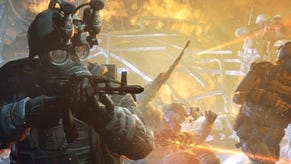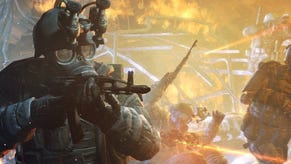THQ clarifies Wii U "horrible, slow" CPU claim, but developer concern remains
"We could probably get Metro to run on an iPad if we wanted."
THQ has clarified comments made by one of the developers of upcoming first-person shooter Metro: Last Light about the Wii U CPU.
This week 4A Games' chief technical officer Oles Shishkovtsov told NowGamer: “[The] Wii U has a horrible, slow CPU” by way of explaining why a Wii U version of Metro wasn't in the works.
Yesterday Eurogamer spoke with THQ's Huw Beynon, who works full time as a representative of 4A Games and Metro, to expand on Shishkovtsov's comment.
“I think there was one comment made by Oles the programmer - the guy who built the engine,” he said.
“It's a very CPU intensive game. I think it's been verified by plenty of other sources, including your own Digital Foundry guys, that the CPU on Wii U on the face of it isn't as fast as some of the other consoles out there. Lots of developers are finding ways to get around that because of other interesting parts of the platform.
“I think that what frustrates me about the way the story's been spun out is that there's been no opportunity to say, 'Well, yes, on that one individual piece maybe it's not as... maybe his opinion is that it's not as easy for the way that the 4A engine's been built as is the others.
“What it doesn't go on to look at is to say that, you know, we could probably get around that. We could probably get Metro to run on an iPad if we wanted, or on pretty much anything. Just as in the same way that between PC and current console versions there are some compromises that need to be made in certain places and we strive to get the very best performance that we can from any platform we release on.
“But I understand that there's a real appetite in the media at the moment because the Wii U is a hot topic to spam some stories that are going to attract a lot of links if they present it in a certain way.”
So, will Metro: Last Light ever appear on Nintendo's first high definition home console?
“We looked at Wii U as a target platform,” Beynon said. "It's a really small studio. There were 50 for Metro 2033, there are 80 now. With Metro 2033 most of their experience was with the PC. The Xbox 360 was their first console version. We've now added PlayStation 3 to the mix.
“We genuinely looked at what it would take to bring the game to Wii U. It's certainly possible, and it's something we thought we'd like to do. The reality is that would mean a dedicated team, dedicated time and effort, and it would either result in a detriment to what we're trying to focus on, already adding a PlayStation 3 SKU, or we probably wouldn't be able to do the Wii U version the justice that we'd want.
“It would be a port or we wouldn't be able to get to grips with the system. That's really the essence of it. It's something we can potentially look at and return to later. Given the targets we've set for the game, it didn't make sense to proceed with it at this point.”
It would be a port or we wouldn't be able to get to grips with the system. That's really the essence of it
THQ's Huw Beynon
Shishkovtsov's quote sparked much debate online about the impact of the Wii U'S IBM PowerPC processor. Wii U developers Eurogamer spoke to for a wide-ranging investigation into the power of the console ahead of its release told us the clock speed offered by it is slower than that of the PS3 and Xbox 360's CPU.
At the Tokyo Game Show in September, Akihiro Suzuki, producer of the Dynasty Warriors franchise, told Eurogamer the performance of the Wii U version of Warriors Orochi 3 Hyper was impacted by it.
"For games in the Warriors series, including Dynasty Warriors and Warriors Orochi, when you have a lot of enemies coming at you at once, the performance tends to be affected because of the CPU,” he said.
"Dealing with that is a challenge."
Last night Gustav Halling, lead designer on Battlefield 3: Armored Kill at Swedish studio DICE, backed up Shishkovtsov, saying on Twitter he was concerned about the impact the next Xbox and PlayStation will have on the Wii U and "annoyed" that Nintendo "don't think ahead at all".
“This is also what I been hearing within the industry, too bad since it will shorten its life a lot when new gen starts,” he said.
Then: “GPU and RAM is nice to have shaders/textures loaded. Physics and gameplay run on CPU mostly so player count is affected etc.”
“I don't actually know what makes it slow, but enough 'tech' people I trust in world are saying the same things.”
But, “Should be a great fun platform if you are a Nintendo fan the coming years and the memory and GPU part looks good!”
The Wii U has 2GB of RAM - 1GB is reserved for system memory and 1GB is available to games - twice the amount inside the PlayStation 3 and the Xbox 360. The GPU is an AMD Radeon High Definition unit with an eDRAM cache built onto the die.
But what, exactly, is going on with the Wii U CPU? To find out, I asked Digital Foundry chief Richard Leadbetter. Here's what he said.
“Outside of dev circles the Wii U CPU is a bit of a mystery. Just about the only confirmed facts are that IBM has produced it and it's been fabricated on a 45nm process - just like the combined CPU/GPU in the Xbox 360.
"Based on rough calculations, the Wii U CPU occupies the same amount of silicon - and so has a roughly similar amount number of transistors - as a single Xbox 360 core (update: plus the L2 cache) in the Xenon tri-core processor. Transistor count alone can't be used to judge 'power' as such (though that's what Moore's Law is based on) but it's safe to say there'd need to be a huge amount of efficiency gains to produce anything like the same amount of processing power as the 360 with that silicon budget."
Leadbetter added: "While we're on the subject of power, it is worth pointing out that an Xbox 360 Slim draws around 70 watts from the mains. The Wii U is closer to 35 watts. In terms of overall performance from power consumed, that's rather impressive.”









